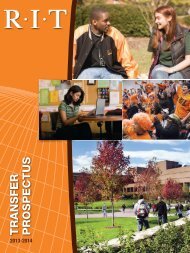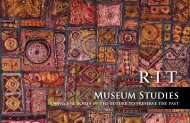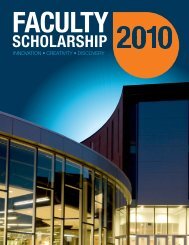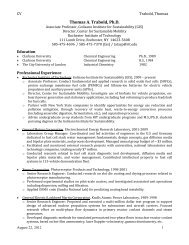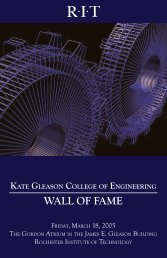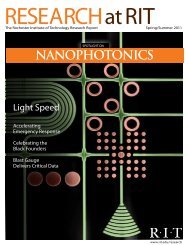Fall / Winter 2012 - Rochester Institute of Technology
Fall / Winter 2012 - Rochester Institute of Technology
Fall / Winter 2012 - Rochester Institute of Technology
Create successful ePaper yourself
Turn your PDF publications into a flip-book with our unique Google optimized e-Paper software.
Focus Area | Imaging the Earth<br />
Thermal Mapping: Working with the Jet Propulsion Lab, Schott is assisting the<br />
USGS in creating land-surface temperature maps that will allow scientists to<br />
assess how different aspects <strong>of</strong> the Earth have changed over time.<br />
Creating the Next-Generation Imaging Satellite: The team is working<br />
with the Goddard Space Flight Center to design key instrumentation<br />
for Landsat 8, which is scheduled to launch in <strong>2012</strong>. This includes<br />
testing <strong>of</strong> the Thermal Infrared Sensor, pictured above, which utilizes<br />
novel detector technology that has never been tested in space.<br />
Photo provided by Matthew Montero, Goddard Space Flight Center.<br />
Landsat 8 is “a very different sensor,”<br />
Schott says.<br />
The satellite will view Earth with two<br />
separate cameras. The Operational Land<br />
Imager (OLI) will detect visible light and<br />
the Thermal Infrared Sensor (TIRS) will<br />
cover the infrared part <strong>of</strong> the spectrum.<br />
Ball Aerospace in Colorado is building<br />
OLI and the NASA Goddard Space Flight<br />
Center is building TIRS.<br />
Landsat 7 has 16 detectors to generate<br />
all the information in each region <strong>of</strong> the<br />
spectrum. All 16 had to be cross-calibrated<br />
so they responded in the same<br />
manner. In contrast, OLI has a staggering<br />
12,000 blue detectors that must be manufactured<br />
and calibrated so they respond in<br />
unison. On the thermal side, TIRS represents<br />
new detector technology that has<br />
never been tested in space, Schott says.<br />
The high spatial resolution and the<br />
significantly improved radiometric resolution<br />
will enable detailed mapping <strong>of</strong> fresh<br />
and coastal waters, a particular interest <strong>of</strong><br />
Schott’s and one that, in the future, could<br />
help small municipalities monitor the<br />
quality <strong>of</strong> their fresh water supply.<br />
“John is probably one <strong>of</strong> the few<br />
people in the country with over 30 years<br />
<strong>of</strong> Landsat experience. He knows their<br />
capabilities and their weaknesses,” says<br />
Matthew Montanaro, a calibration scientist<br />
with Sigma Space Corp., a contractor<br />
to NASA Goddard for design <strong>of</strong> Landsat<br />
8’s TIRS instrument.<br />
“Being a member <strong>of</strong> the science team<br />
has allowed John to influence the design<br />
<strong>of</strong> Landsat 8,” adds Montanaro, who<br />
was a student <strong>of</strong> Schott’s while earning<br />
his doctorate in imaging science at RIT.<br />
“John will also continue his involvement<br />
in characterizing the Landsat 8 instruments<br />
after launch as he has been doing<br />
for Landsat 5 and 7. This allows him to be<br />
involved with making sure that the entire<br />
past and future Landsat archive will be as<br />
accurate as possible.”<br />
Simulating Satellite Operation<br />
Montanaro relies on Schott’s team to<br />
simulate potential problems in the development<br />
<strong>of</strong> Landsat 8 through the use <strong>of</strong><br />
Digital Imaging and Remote Sensing<br />
Image Generation (DIRSIG), a synthetic<br />
image-generation tool developed by<br />
Schott and Carl Salvaggio, associate<br />
pr<strong>of</strong>essor <strong>of</strong> imaging science at RIT.<br />
The tool simulates in a computer what<br />
an aerial or satellite remote sensing<br />
system would see by modeling the<br />
thermal and radiometric behavior <strong>of</strong><br />
the Earth and atmosphere.<br />
The team utilized DIRSIG to build<br />
Research at RIT<br />
17






